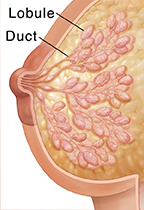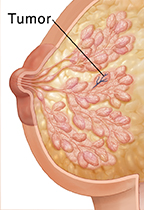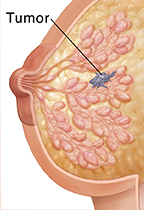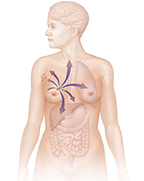What Is Breast Cancer?
Having breast cancer means cells in your breast have changed (mutated) and are growing out of control. Learning about the different types and stages of breast cancer can help you take an active role in your treatment decisions.
Changes in your breast
Your entire body is made of living tissue. This tissue is made up of tiny cells. You can't see these cells with the naked eye. Normal cells grow and divide (reproduce) in a controlled way. They grow when your body needs them, and die when your body doesn't need them anymore. When you have cancer, some cells change or become abnormal. These cells divide quickly, don't die when they should, and can spread into other parts of the body. Breast cancer can start in different tissues in the breast.
|

|

|
|
Normal breast tissue is made of healthy cells. They divide to make new cells that look and work the same.
A breast is made of 3 main parts. Lobules make milk. Ducts carry milk to the nipple. Connective tissue is the fibrous and fatty tissue that makes up the rest of the breast. Most breast cancers start in the lobules or ducts.
|
Ductal carcinoma is when cancer cells are only in the ducts. It's also called ductal carcinoma in situ.
Noninvasive breast cancer doesn't go beyond the lobules or ducts where it first started.
|
|

|

|
|
Invasive (or infiltrating) breast cancer happens when cancer cells spread outside of the ducts or lobules and into nearby breast tissue. Invasive ductal carcinoma and invasive lobular carcinoma are the most common kinds of invasive breast cancer.
|
Metastasis happens when cancer cells move into the lymph nodes or blood and travel to another part of the body.
|
Stages of breast cancer
After breast cancer is diagnosed, tests are needed to learn more about it. These tests include imaging scans, hormone receptor tests, and genetic testing of the tumor. This process is called staging. The stage of your cancer will help to decide which treatment plan is best for you. Staging will tell you:
-
The size of the tumor
-
If the cancer has spread to lymph nodes
-
If the cancer has spread (metastasized) to other parts of the body
-
Estrogen receptor status
-
Progesterone receptor status
-
Her2/neu status
-
Grade of the cancer
All of this information is used to put breast cancers into stage groups. The groups range from 0 to 4 and are written as Roman numerals (0, I, II, III, IV). Stage 0 is the lowest stage. The cancer is only found in the lining of the breast duct. Stage 0 may also be called DCIS (ductal carcinoma in situ). Stage IV is the highest stage. It means that the cancer has spread beyond the breast to other parts of the body, like the bones, lungs, brain, or liver. The other stages range in between.
The stages of breast cancer are very complex. But the more details known about each person's cancer, the better healthcare providers are able to focus treatment. Talk with your healthcare team about your stage, what it means for you, and how it affects your treatment plan and long-term outcomes.
How daily issues affect your health
Many things in your daily life impact your health. This can include transportation, money problems, housing, access to food, and child care. If you can’t get to medical appointments, you may not receive the care you need. When money is tight, it may be difficult to pay for medicines. And living far from a grocery store can make it hard to buy healthy food.
If you have concerns in any of these or other areas, talk with your healthcare team. They may know of local resources to assist you. Or they may have a staff person who can help.